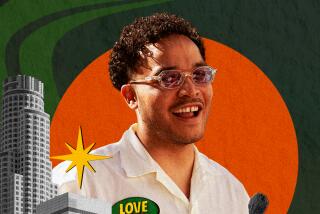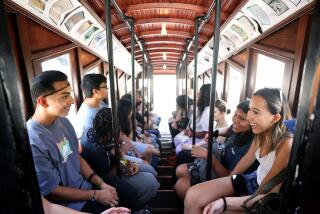Widening Their View of Los Angeles
- Share via
Rosalinda Hill, a South-Central Los Angeles mother of five, spends almost all of her family’s disposable income buying her 16-year-old son skateboards. She and her husband aren’t spoiling him. They’re trying to keep him out of gangs.
“I literally work to buy him skateboards,” said Hill, a 36-year-old who does volunteer work in Watts. Hill forbids her son to pursue his passion in their neighborhood, sending him by bus to what she considers the relative safety of Venice Beach. “Instead of worrying about his education, I have to worry about his life.”
For a group of affluent mostly white Westsiders who had gathered for lunch at a Watts community center on a recent Saturday, Hill’s comments were a stunning lesson in the realities of life on the other side of the city’s vast socioeconomic divide.
The groups boarded a chartered, air-conditioned bus and ventured, like foreigners in their own city, to three neighboring communities they would rarely visit on their own: Koreatown, Pico-Union and Watts. Their encounters demonstrated the balkanization and isolation of L.A.’s neighborhoods and communities, separated by only a few miles yet often worlds apart.
The “consciousness-raising” tour was organized by Liberty Hill Foundation, which awards grants to grass-roots community organizations working for social and economic change. “Most affluent Angelenos don’t know what it’s like for poor black and brown kids on the streets of Watts,” said Liberty Hill executive director Torie Osborn, who made a name for herself as a leader in the gay and lesbian movement.
“I think it’s a revelation to sit in a room that’s safe enough to hear a mom describe the realities of life in Watts with a busload of white people coming from the Westside.”
Founded 24 years ago by four wealthy philanthropists including heiress and movie producer Sarah Pillsbury, Liberty Hill last year awarded 250 grants totaling $1.7 million to an array of Southern California community groups. Named for the hill in San Pedro where Upton Sinclair was arrested in 1923 during a rally to free jailed union organizers, Liberty Hill annually organizes about four tours to encourage its wealthy donors to increase their giving.
The most recent tour--”From Immigrant to New American”-- earlier this month served as kind of crash course in the plight of the city’s immigrants. After tanking up on coffee and bagels at Liberty Hill’s austere Santa Monica office, about 40 current or potential donors--mostly men and women who work in the entertainment industry--set off on the five-hour tour.
Several first-time participants expressed concern that the tour would feel “voyeuristic.” Donor Sharon Smith, who works as a film music editor, said before the tour, it seems “an odd thing to do, like peering into a fishbowl.”
*
In 15 minutes, the bus reached its first destination: Korean Immigrant Workers Advocates, which organizes immigrant workers in the restaurant and garment industries to seek the minimum wage and workplace protections.
Paul Lee, a trilingual KIWA organizer, greeted the group by acknowledging that most Angelenos have gleaned virtually everything they know about Korean culture from their exposure to Korean restaurants. But, Lee said, most restaurant patrons are completely oblivious to the fact that terrible abuses are occurring behind many of those kitchen doors.
In 1997, KIWA found that 97% of Koreatown-area restaurants exploited their workers by making them work long hours at wages significantly under the minimum wage. Educational seminars and the occasional boycott have helped bring the violation rate down to 41%, he said.
Not everyone was able to absorb the numbers. One woman dozed, and a couple of cell phones went off before Lee finished his presentation. But the group perked up significantly when Lee introduced Korean immigrant Lee Jung-Hee, a former restaurant worker who now is a KIWA organizer.
Lee Jung-Hee, whose comments were translated by Paul Lee into English, told the group that she came to Los Angeles six years ago to go to school but that after the birth of her first child she took a job in a Korean restaurant to help pay the bills. For a year, she worked 12-hour days, at least five days a week, earning $600 a month, before she learned that she was receiving just half of the minimum wage.
She soon left that job and went to work for KIWA, where she now helps educate recent immigrant workers about their workplace rights. “I used to fight a lot with my husband because I was working so many hours and didn’t have much time to spend with my family. Twice, I almost got divorced,” she said. “Now, working to assist other workers is very liberating to me.”
The visitors asked pointed questions about why the restaurants were not shut down. They learned that an ethnic enclave economy often depends on undocumented workers to thrive.
Soon the tourists were headed northeast toward Pico-Union to the Central American Resource Center, which provides legal services and civic and cultural programs to Central American immigrants.
En route, Liberty Hill development director Catherine Suitor pointed out several local landmarks, including Hoover Elementary School, which Suitor said was featured in the documentary “Fear and Learning at Hoover Elementary”; MacArthur Park, which Suitor identified as the drug capital of Los Angeles; and Rampart division police station, which needed no introduction.
“So this is Rampart!” one woman exclaimed, drawing knowing nods from several fellow travelers. Soon, the group entered Central American Resource Center and met executive director Angela Sanbrano, who gave the group a brief but comprehensive overview of political activism in the Central American community. The center was founded in the early ‘70s to push the U.S. government to recognize Central American immigrants as refugees so they would qualify for survival services, she said.
While Liberty Hill was one of center’s earliest funding sources, the center since has matured into one of the nation’s most highly acclaimed resource centers for Central Americans, Sanbrano said. The community center, which once could not afford a fax machine, today employs a staff of 30 in a four-story building and is a hub of activity, offering services from classes to political organizing.
*
The last stop of the day was the Watts/Century Latino Organization, which works on economic development programs, violence prevention and school reform. The tourists became noticeably quiet as the bus drove past the Watts neighborhood sign and Watts Towers to the parking lot of the center.
Executive director Arturo Ybarra, a survivor of the Oct. 2, 1968, massacre in Mexico and who was jailed and tortured before he immigrated to the United States, drew nervous laughter when he welcomed the group, saying, “It’s a privilege having you here, because now you will be able to say you came to Watts and survived.”
As the group settled into a hearty lunch of chile rellenos, beans and rice, Ybarra introduced several teenagers who talked about the challenges they face growing up in Watts. One teenager painted a grim portrait of Jordan High School.
“The bathrooms don’t work and our books are old, out of date,” he said. “We just got some new computers, but they didn’t install them yet. The buildings are old. There’s a lot of graffiti.”
Mary Catlin, a widow with three children between the ages of 8 and 21 and who works at the Watts/Century center, spoke about how hard it is for black men to get jobs, especially if they have spent any time in jail.
When Hill, a volunteer who used to live in Watts, spoke about how skateboards were keeping her son alive, it became clear that the full message of the day’s activities had been delivered. Pillsbury, who accompanied the tour, said, “You read statistics, but you don’t think about how it feels, you don’t realize what kind of challenges people face, until you hear a mom talk about what she has to do to keep her kids out of gangs.”
*
By the end of tour, Smith, who had made the fishbowl comment, and others went home feeling their time had been well spent, and at least two planned to make additional donations. “These groups are dying for an audience,” said Gary Stewart, a Rhino records executive who serves on Liberty Hill’s board and participated in the tour. “They’re saying thank you for coming out and hearing our stories. It’s much more about our discomfort than that of the people we visit.”
More to Read
Sign up for Essential California
The most important California stories and recommendations in your inbox every morning.
You may occasionally receive promotional content from the Los Angeles Times.










